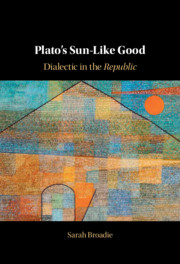Book contents
- Plato’s Sun-Like Good
- Plato’s Sun-Like Good
- Copyright page
- Dedication
- Contents
- Acknowledgements
- Part 1 Approaching the Sun-Good Analogy
- Part 2 The Form of the Good and Knowledge
- Part 3 The Form of the Good and Being
- Part 4 Various Further Questions
- Part 5 Winding Up
- References
- Index of Passages
- General Index
Part 2 - The Form of the Good and Knowledge
Published online by Cambridge University Press: 08 July 2021
- Plato’s Sun-Like Good
- Plato’s Sun-Like Good
- Copyright page
- Dedication
- Contents
- Acknowledgements
- Part 1 Approaching the Sun-Good Analogy
- Part 2 The Form of the Good and Knowledge
- Part 3 The Form of the Good and Being
- Part 4 Various Further Questions
- Part 5 Winding Up
- References
- Index of Passages
- General Index
Summary
The main aim of Part 2 is to explain how the form of the good gives rise to knowledge of forms, the forms in question being of virtues and virtue-related things. This ramifies into discussions of dialectic and mathematics, the ambiguous property 'clearness' (saphēneia), hypotheses, and the non-hypothetical principle. It is proposed that the form of the good is interrogative. This position is defended against philosophical and textual objections, and argued to be preferable to alternatives. There is discussion of why Plato excludes the use of diagrams from dialectic and whether he can allow input from experience. The role of context in the rulers' dialectic is explained, and becomes the basis for explaining why Plato's treatment of dialectic in the Republic remains at the level of a sketch. There is an exploration of the difference between true philosophers and sight-lovers, and of the criteria and scope of 'good' in dialectic. This last discussion encounters the classic problem of the connection between Plato's 'justice in the soul' and just conduct as ordinarily recognized, and a solution to this problem is proposed.
Keywords
- Type
- Chapter
- Information
- Plato's Sun-Like GoodDialectic in the Republic, pp. 13 - 135Publisher: Cambridge University PressPrint publication year: 2021



